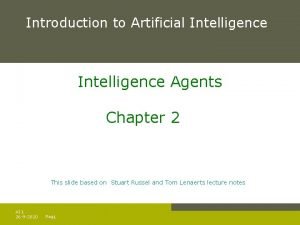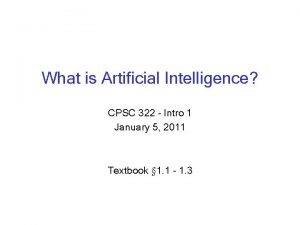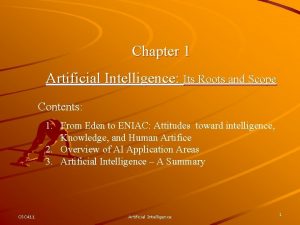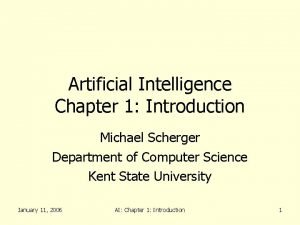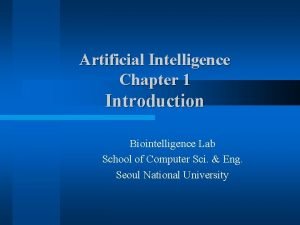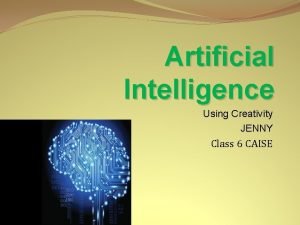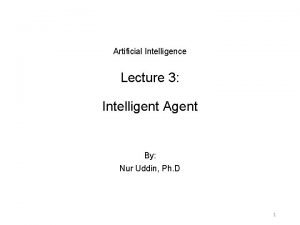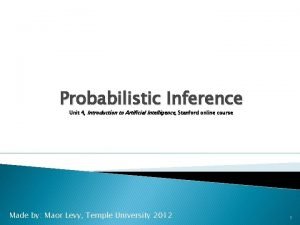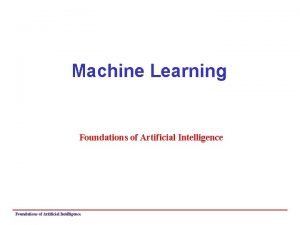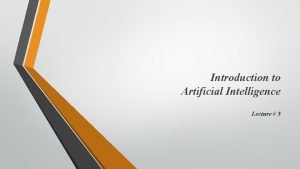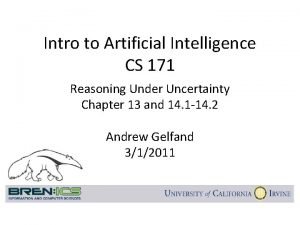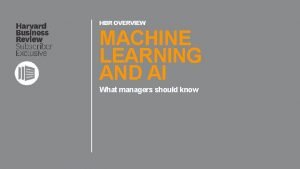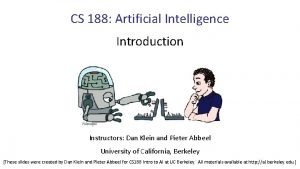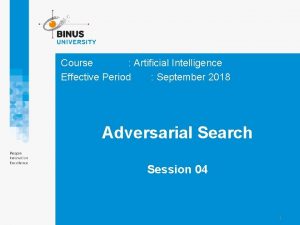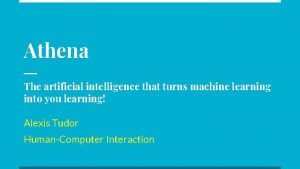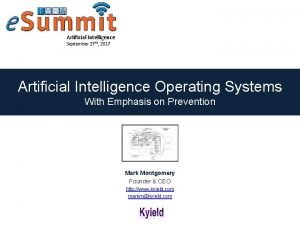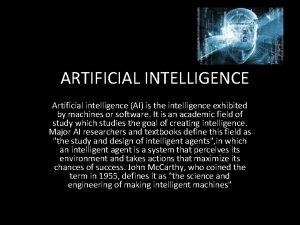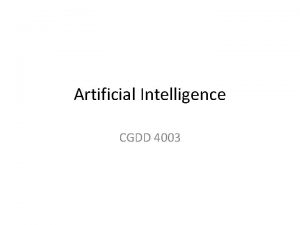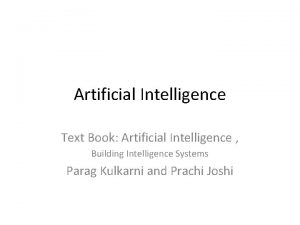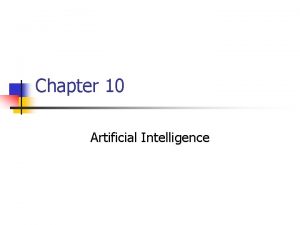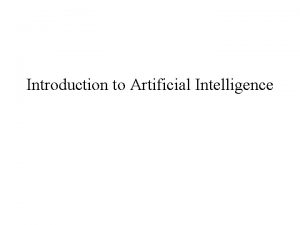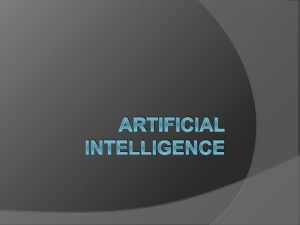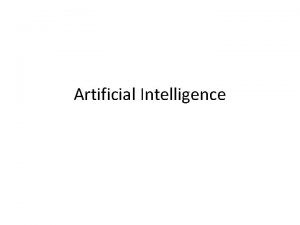Introduction to Artificial Intelligence Agents Chapter 2 This





![The vacuum-cleaner world Environment: square A and B Percepts: [location and content] e. g. The vacuum-cleaner world Environment: square A and B Percepts: [location and content] e. g.](https://slidetodoc.com/presentation_image/c3c9c5ba57bfac9dc0c5b41a878a4b14/image-6.jpg)

![The vacuum-cleaner world function REFLEX-VACUUM-AGENT ([location, status]) return an action if status == Dirty The vacuum-cleaner world function REFLEX-VACUUM-AGENT ([location, status]) return an action if status == Dirty](https://slidetodoc.com/presentation_image/c3c9c5ba57bfac9dc0c5b41a878a4b14/image-8.jpg)

























![The vacuum-cleaner world function REFLEX-VACUUM-AGENT ([location, status]) return an action if status == Dirty The vacuum-cleaner world function REFLEX-VACUUM-AGENT ([location, status]) return an action if status == Dirty](https://slidetodoc.com/presentation_image/c3c9c5ba57bfac9dc0c5b41a878a4b14/image-34.jpg)







- Slides: 41

Introduction to Artificial Intelligence Agents Chapter 2 This slide based on Stuart Russel and Tom Lenaerts lecture notes AI 1 26 -9 -2020 Pag. 1

Outline Agents and environments. – The vacuum-cleaner world The concept of rational behavior. Environments. Agent structure. AI 1 26 -9 -2020 Pag. 2

Agents - An agent is anything that can be viewed as perceiving its environment through sensors and acting upon that environment through actuators - Human agent: eyes, ears, and other organs for sensors; hands, legs, mouth, and other body parts for actuators - Robotic agent: cameras and infrared range finders for sensors: various motors for actuators AI 1 26 -9 -2020 Pag. 3

Agents and environments Agents include human, robots, softbots, thermostats, etc. The agent function maps percept sequence to actions An agent can perceive its own actions, but not always it effects. AI 1 26 -9 -2020 Pag. 4

Agents and environments The agent function will internally be represented by the agent program. The agent program runs on the physical architecture to produce f. agent = architecture + program AI 1 26 -9 -2020 Pag. 5
![The vacuumcleaner world Environment square A and B Percepts location and content e g The vacuum-cleaner world Environment: square A and B Percepts: [location and content] e. g.](https://slidetodoc.com/presentation_image/c3c9c5ba57bfac9dc0c5b41a878a4b14/image-6.jpg)
The vacuum-cleaner world Environment: square A and B Percepts: [location and content] e. g. [A, Dirty] Actions: left, right, suck, and no-op AI 1 26 -9 -2020 Pag. 6

The vacuum-cleaner world AI 1 26 -9 -2020 Pag. 7 Percept sequence Action [A, Clean] Right [A, Dirty] Suck [B, Clean] Left [B, Dirty] Suck [A, Clean], [A, Clean] Right [A, Clean], [A, Dirty] Suck … …
![The vacuumcleaner world function REFLEXVACUUMAGENT location status return an action if status Dirty The vacuum-cleaner world function REFLEX-VACUUM-AGENT ([location, status]) return an action if status == Dirty](https://slidetodoc.com/presentation_image/c3c9c5ba57bfac9dc0c5b41a878a4b14/image-8.jpg)
The vacuum-cleaner world function REFLEX-VACUUM-AGENT ([location, status]) return an action if status == Dirty then return Suck else if location == A then return Right else if location == B then return Left What is the right function? Can it be implemented in a small agent program? AI 1 26 -9 -2020 Pag. 8

The concept of rationality A rational agent is one that does the right thing. – Every entry in the table is filled out correctly. What is the right thing? – Approximation: the most successful agent. – Measure of success? Performance measure should be objective – E. g. the amount of dirt cleaned within a certain time. – E. g. how clean the floor is. – … Performance measure according to what is wanted in the environment instead of how the agents should behave. AI 1 26 -9 -2020 Pag. 9

Rationality What is rational at a given time depends on four things: – – Performance measure, Prior environment knowledge, Actions, Percept sequence to date (sensors). DEF: A rational agent chooses whichever action maximizes the expected value of the performance measure given the percept sequence to date and prior environment knowledge. AI 1 26 -9 -2020 Pag. 10

Rationality omniscience – An omniscient agent knows the actual outcome of its actions. Rationality perfection – Rationality maximizes expected performance, while perfection maximizes actual performance. Omniscience = possessed of universal or complete knowledge AI 1 26 -9 -2020 Pag. 11

Rationality The proposed definition requires: – Information gathering/exploration – To maximize future rewards – Learn from percepts – Extending prior knowledge – Agent autonomy – Compensate for incorrect prior knowledge AI 1 26 -9 -2020 Pag. 12

AI 1 26 -9 -2020 Pag. 13

Environments To design a rational agent we must specify its task environment. PEAS description of the environment: – Performance – Environment – Actuators – Sensors AI 1 26 -9 -2020 Pag. 14

Environments E. g. Fully automated taxi: – PEAS description of the environment: – Performance » Safety, destination, profits, legality, comfort – Environment » Streets/freeways, other traffic, pedestrians, weather, , … – Actuators » Steering, accelerating, brake, horn, speaker/display, … – Sensors » Video, sonar, speedometer, engine sensors, keyboard, GPS, … AI 1 26 -9 -2020 Pag. 15

Environment types Solitaire Observable? ? Deterministic? ? Episodic? ? Static? ? Discrete? ? Single-agent? ? AI 1 26 -9 -2020 Pag. 16 Backgammom Internet shopping Taxi

Environment types Fully vs. partially observable: an environment is full observable when the sensors can detect all aspects that are relevant to the choice of action. Solitaire Observable? ? Deterministic? ? Episodic? ? Static? ? Discrete? ? Single-agent? ? AI 1 26 -9 -2020 Pag. 17 Backgammom Internet shopping Taxi

Environment types Fully vs. partially observable: an environment is full observable when the sensors can detect all aspects that are relevant to the choice of action. Observable? ? Deterministic? ? Episodic? ? Static? ? Discrete? ? Single-agent? ? AI 1 26 -9 -2020 Pag. 18 Solitaire Backgammom Internet shopping Taxi FULL PARTIAL

Environment types Deterministic vs. stochastic: if the next environment state is completely determined by the current state the executed action the environment is deterministic. Observable? ? Deterministic? ? Episodic? ? Static? ? Discrete? ? Single-agent? ? AI 1 26 -9 -2020 Pag. 19 Solitaire Backgammom Internet shopping Taxi FULL PARTIAL

Environment types Deterministic vs. stochastic: if the next environment state is completely determined by the current state the executed action the environment is deterministic. Observable? ? Deterministic? ? Episodic? ? Static? ? Discrete? ? Single-agent? ? AI 1 26 -9 -2020 Pag. 20 Solitaire Backgammom Internet shopping Taxi FULL PARTIAL YES NO

Environment types Episodic vs. sequential: In an episodic environment the agent’s experience can be divided into atomic steps where the agents perceives and then performs A single action. The choice of action depends only on the episode itself Observable? ? Deterministic? ? Episodic? ? Static? ? Discrete? ? Single-agent? ? AI 1 26 -9 -2020 Pag. 21 Solitaire Backgammom Internet shopping Taxi FULL PARTIAL YES NO

Environment types Episodic vs. sequential: In an episodic environment the agent’s experience can be divided into atomic steps where the agents perceives and then performs A single action. The choice of action depends only on the episode itself Solitaire Backgammom Internet shopping Taxi FULL PARTIAL Deterministic? ? YES NO Episodic? ? NO NO Observable? ? Static? ? Discrete? ? Single-agent? ? AI 1 26 -9 -2020 Pag. 22

Environment types Static vs. dynamic: If the environment can change while the agent is choosing an action, the environment is dynamic. Semi-dynamic if the agent’s performance changes even when the environment remains the same. Solitaire Backgammom Internet shopping Taxi FULL PARTIAL Deterministic? ? YES NO Episodic? ? NO NO Observable? ? Static? ? Discrete? ? Single-agent? ? AI 1 26 -9 -2020 Pag. 23

Environment types Static vs. dynamic: If the environment can change while the agent is choosing an action, the environment is dynamic. Semi-dynamic if the agent’s performance changes even when the environment remains the same. Solitaire Backgammom Internet shopping Taxi FULL PARTIAL Deterministic? ? YES NO Episodic? ? NO NO Static? ? YES SEMI NO Observable? ? Discrete? ? Single-agent? ? AI 1 26 -9 -2020 Pag. 24

Environment types Discrete vs. continuous: This distinction can be applied to the state of the environment, the way time is handled and to the percepts/actions of the agent. Solitaire Backgammom Internet shopping Taxi FULL PARTIAL Deterministic? ? YES NO Episodic? ? NO NO Static? ? YES SEMI NO Observable? ? Discrete? ? Single-agent? ? AI 1 26 -9 -2020 Pag. 25

Environment types Discrete vs. continuous: This distinction can be applied to the state of the environment, the way time is handled and to the percepts/actions of the agent. Solitaire Backgammom Internet shopping Taxi FULL PARTIAL Deterministic? ? YES NO Episodic? ? NO NO Static? ? YES SEMI NO Discrete? ? YES YES NO Observable? ? Single-agent? ? AI 1 26 -9 -2020 Pag. 26

Environment types Single vs. multi-agent: Does the environment contain other agents who are also maximizing some performance measure that depends on the current agent’s actions? Solitaire Backgammom Internet shopping Taxi FULL PARTIAL Deterministic? ? YES NO Episodic? ? NO NO Static? ? YES SEMI NO Discrete? ? YES YES NO Observable? ? Single-agent? ? AI 1 26 -9 -2020 Pag. 27

Environment types Single vs. multi-agent: Does the environment contain other agents who are also maximizing some performance measure that depends on the current agent’s actions? Solitaire Backgammom Internet shopping Taxi FULL PARTIAL Deterministic? ? YES NO Episodic? ? NO NO Static? ? YES SEMI NO Discrete? ? YES YES NO Single-agent? ? YES NO NO NO Observable? ? AI 1 26 -9 -2020 Pag. 28

Environment types The simplest environment is – Fully observable, deterministic, episodic, static, discrete and single-agent. Most real situations are: – Partially observable, stochastic, sequential, dynamic, continuous and multi-agent. AI 1 26 -9 -2020 Pag. 29

Agent types How does the inside of the agent work? – Agent = architecture + program All agents have the same skeleton: – Input = current percepts – Output = action – Program= manipulates input to produce output Note difference with agent function. AI 1 26 -9 -2020 Pag. 30

Agent types Function TABLE-DRIVEN_AGENT(percept) returns an action static: percepts, a sequence initially empty table, a table of actions, indexed by percept sequence append percept to the end of percepts action LOOKUP(percepts, table) return action This approach is doomed to failure AI 1 26 -9 -2020 Pag. 31

Agent types Four basic kind of agent programs will be discussed: – – Simple reflex agents Model-based reflex agents Goal-based agents Utility-based agents All these can be turned into learning agents. AI 1 26 -9 -2020 Pag. 32

Agent types; simple reflex Select action on the basis of only the current percept. – E. g. the vacuum-agent Large reduction in possible percept/action situations(next page). Implemented through condition-action rules – If dirty then suck AI 1 26 -9 -2020 Pag. 33
![The vacuumcleaner world function REFLEXVACUUMAGENT location status return an action if status Dirty The vacuum-cleaner world function REFLEX-VACUUM-AGENT ([location, status]) return an action if status == Dirty](https://slidetodoc.com/presentation_image/c3c9c5ba57bfac9dc0c5b41a878a4b14/image-34.jpg)
The vacuum-cleaner world function REFLEX-VACUUM-AGENT ([location, status]) return an action if status == Dirty then return Suck else if location == A then return Right else if location == B then return Left Reduction from 4 T to 4 entries AI 1 26 -9 -2020 Pag. 34

Agent types; simple reflex function SIMPLE-REFLEX-AGENT(percept) returns an action static: rules, a set of condition-action rules state INTERPRET-INPUT(percept) rule RULE-MATCH(state, rule) action RULE-ACTION[rule] return action Will only work if the environment is fully observable otherwise infinite loops may occur. AI 1 26 -9 -2020 Pag. 35

Agent types; reflex and state (Model-based reflex agents) To tackle partially observable environments. – Maintain internal state Over time update state using world knowledge – How does the world change. – How do actions affect world. Model of World AI 1 26 -9 -2020 Pag. 36

Agent types; reflex and state function REFLEX-AGENT-WITH-STATE(percept) returns an action static: rules, a set of condition-action rules state, a description of the current world state action, the most recent action. state UPDATE-STATE(state, action, percept) rule RULE-MATCH(state, rule) action RULE-ACTION[rule] return action AI 1 26 -9 -2020 Pag. 37

Agent types; goal-based The agent needs a goal to know which situations are desirable. – Things become difficult when long sequences of actions are required to find the goal. Typically investigated in search and planning research. Major difference: future is taken into account Is more flexible since knowledge is represented explicitly and can be manipulated. AI 1 26 -9 -2020 Pag. 38

Agent types; utility-based Certain goals can be reached in different ways. – Some are better, have a higher utility. Utility function maps a (sequence of) state(s) onto a real number. Improves on goals: – Selecting between conflicting goals – Select appropriately between several goals based on likelihood of success. AI 1 26 -9 -2020 Pag. 39

Agent types; learning All previous agentprograms describe methods for selecting actions. – Yet it does not explain the origin of these programs. – Learning mechanisms can be used to perform this task. – Teach them instead of instructing them. – Advantage is the robustness of the program toward initially unknown environments. AI 1 26 -9 -2020 Pag. 40

Agent types; learning Learning element: introduce improvements in performance element. – Critic provides feedback on agents performance based on fixed performance standard. Performance element: selecting actions based on percepts. – Corresponds to the previous agent programs Problem generator: suggests actions that will lead to new and informative experiences. – Exploration vs. exploitation AI 1 26 -9 -2020 Pag. 41
 Artificial probing chapter 2
Artificial probing chapter 2 Pxdes expert system
Pxdes expert system Cpsc 322: introduction to artificial intelligence
Cpsc 322: introduction to artificial intelligence Cpsc 322: introduction to artificial intelligence
Cpsc 322: introduction to artificial intelligence Artificial intelligence chapter 3
Artificial intelligence chapter 3 Artificial intelligence chapter 1
Artificial intelligence chapter 1 Artificial intelligence chapter 1
Artificial intelligence chapter 1 Artificial intelligence chapter 1
Artificial intelligence chapter 1 Knowledge engineer in expert system
Knowledge engineer in expert system State space search in ai
State space search in ai Searching for solutions in artificial intelligence
Searching for solutions in artificial intelligence 15-780 graduate artificial intelligence
15-780 graduate artificial intelligence Knowledge manipulation in ai
Knowledge manipulation in ai Procedural knowledge in ai
Procedural knowledge in ai Vandelay art. seinfeld the show about nothing. penguin 1997
Vandelay art. seinfeld the show about nothing. penguin 1997 Kecerdasan kepemimpinan
Kecerdasan kepemimpinan Uas kecerdasan buatan
Uas kecerdasan buatan Math and artificial intelligence
Math and artificial intelligence Peas in artificial intelligence
Peas in artificial intelligence 15-780 graduate artificial intelligence
15-780 graduate artificial intelligence Xkcd deep learning
Xkcd deep learning Fuzzy propositions in artificial intelligence
Fuzzy propositions in artificial intelligence Cse 571
Cse 571 15 780
15 780 Informed search and uninformed search
Informed search and uninformed search Artificial intelligence for class 6
Artificial intelligence for class 6 Levels of language analysis
Levels of language analysis Omniscience in artificial intelligence
Omniscience in artificial intelligence Int404
Int404 Partitioned semantic network in artificial intelligence
Partitioned semantic network in artificial intelligence A* and ao*
A* and ao* Artificial intelligence thesis proposals
Artificial intelligence thesis proposals Rule based deduction system
Rule based deduction system Inference by enumeration in artificial intelligence
Inference by enumeration in artificial intelligence Learning in ai
Learning in ai Production rules for water jug problem
Production rules for water jug problem Optimal decisions in games in artificial intelligence
Optimal decisions in games in artificial intelligence Hbr machine learning
Hbr machine learning Cs188 artificial intelligence
Cs188 artificial intelligence Optimal decisions in games in artificial intelligence
Optimal decisions in games in artificial intelligence Athena artificial intelligence
Athena artificial intelligence Types of artificial intelligencel
Types of artificial intelligencel
